#amazon drought
Explore tagged Tumblr posts
Text
Science Speaks: Recent Findings on Unprecedented Drought in the Amazon Rainforest
Introduction
The Amazon rainforest, often referred to as the "lungs of the Earth," is facing an unprecedented threat—a severe drought that could have far-reaching consequences on the delicate balance of this vital ecosystem. In recent years, the Amazon rainforest has been experiencing unusual weather patterns, with prolonged periods of drought disrupting its normal climate cycles.

The Impact of Drought on the Amazon Rainforest Ecosystem
The effects of this prolonged drought are not limited to parched vegetation and thirsty animals. The disruption of the water cycle has cascading effects on the entire Amazon rainforest ecosystem. Plants and animals dependent on regular rainfall face challenges in finding water, leading to a decline in biodiversity.
For more info visit: Sonicbulletinhub
0 notes
Text
30./31.10.23
Worum's geht: Wanderung zum Schildpladdenberg, kleine Überlebenslektion im Video und ausgetrocknete Bäche.

Wanderstrecke und Anstieg zum Schildpladdenberg sind an sich keine Herausforderung. Doch wir stapfen durch unwegsames Gelände, wehren Mücken ab und bleiben immer wieder atemlos stehen, weil es etwas Seltsames zu hören gibt, jemand in ein immenses Spinnennetz läuft und vor der krabbelnden "Gefahr" gerettet werden muss (Sensi), oder weil wir grabende Wildschweine entdecken. In der Ferne grölen die Brüllaffen (Alouatta macconnelli), was schon zuvor und vor allem nachts für Gänsehaut gesorgt hat. Sensi erklärt, das Brüllen sei territoriales Verhalten und während er redet, kratzt er sich mit seiner Machete gemütlich den Arm. Wir können am Anfang der Wanderung Wasser in einem Bach nachfüllen, doch er führt wenig Wasser. Als wir am 31. Oktober ein ausgetrocknetes Flussbett überqueren, bleibt Sensi stehen und stützt die Hände an der Hüfte ab. Kopfschüttelnd blickt er um sich und murmelt: "In the twenty-something years that I worked as a tourguide, I have never seen this creek dry."
Später warten wir fast eine dreiviertel Stunde am Ufer des Gran Rio auf Bootsmann Hesti. Sensi schimpft wie ein Rohrspatz über die Unzuverlässigkeit seiner Leute. Wir können es nicht ganz ernst nehmen und selbst Freddy, der sonst wenig Emotionen zeigt, wendet sich ab, weil er sich ein Grinsen nicht verkneifen kann. Sensi kann nichts dafür, dass er selbst im Ärger bühnereife Komik beweist, indem er das Opfer seines Tadels mit hoher Stimme nachäfft. Der jüngere der beiden Brüder, mit denen ich reise, fragt, ob er heute wieder angeln gehen könne. Sensi hält inne und sagt dann: Natürlich. Aber ich bilde mir ein, dass er innerlich den Kopf schüttelt.
Jetzt ruhe ich mich in meiner Hängematte aus, frisch gebadet und doch erneut nassgeschwitzt. Die Brüder versuchen wieder ihr Glück mit Angeln, obwohl genug Fisch im Haus ist. Der jüngere der beiden besteht darauf, denn er hat gestern nichts an Land geholt, Freddy und ich hingegen schon (einen riesigen Piranha und einen Anyumara - ich berichtete bereits mit kaum verhohlter Schadenfreude und werde nicht müde, davon zu erzählen). Um mich herum schwirren die Fledermäuse. Ein weiterer heißer Tag geht zu Ende.
0 notes
Text
A Changing Climate Is Scorching the World’s Biggest River. (New York Times)

Excerpt from this New York Times story:
The world’s largest river is parched.
The Amazon River, battered by back-to-back droughts fueled by climate change, is drying up, with some stretches of the mighty waterway dwindling to shallow pools only a few feet deep.
Water levels along several sections of the Amazon River, which winds nearly 4,000 miles across South America, fell last month to their lowest level on record, according to figures from the Brazilian Geological Service.
In one stretch in the Brazilian state of Amazonas, the river was 25 feet below the average for this time of year, according to the agency, which began collecting data in 1967.
Parts of three of the Amazon River’s most important tributaries — major rivers in their own right, each spanning over 1,000 miles — have also fallen to historical lows.
The crisis has gridlocked the Amazon, a vital watery superhighway that serves as practically the only way to connect forest communities and move commerce around some of the most remote stretches on the planet.
Faced with a situation that shows no sign of abating, Brazil has resorted to an extraordinary measure that might have been unthinkable not too long ago: making the world’s largest river deeper.
Starting this month, the country plans to begin dredging sections of the river with the aim of ensuring that, even in times of drought, people and goods can keep moving through the rainforest.
“In some places, we can practically see the vegetation on the surface of the river,” the water so low that plants on the riverbed are exposed, said Fabricio de Oliveira Galvão, the director of the National Department of Transport Infrastructure, a federal agency. “So, this limits navigation. People aren’t able to travel like this.”
The remarkable drop in water levels has left boats struggling to shuttle children to school, rush the sick to hospitals or deliver medicine and drinking water to distant villages.
73 notes
·
View notes
Text


Amazon Drought Exposes Ancient Rock Carvings
Human faces sculpted into stone up to 2,000 years ago have appeared on a rocky outcropping along the Amazon River since water levels dropped to record lows in the region’s worst drought in more than a century.
Some rock carvings had been sighted before but now there is a greater variety that will help researchers establish their origins, archaeologist Jaime de Santana Oliveira said on Monday.

One area shows smooth grooves in the rock thought to be where Indigenous inhabitants once sharpened their arrows and spears long before Europeans arrived.
“The engravings are prehistoric, or precolonial. We cannot date them exactly, but based on evidence of human occupation of the area, we believe they are about 1,000 to 2,000 years old,” Oliveira said in an interview.

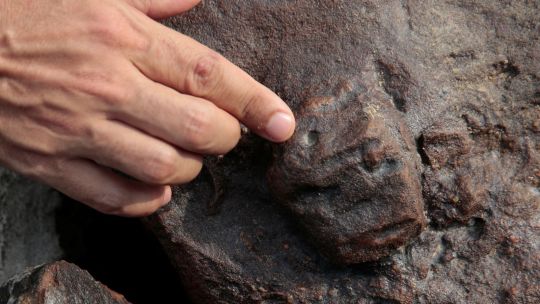
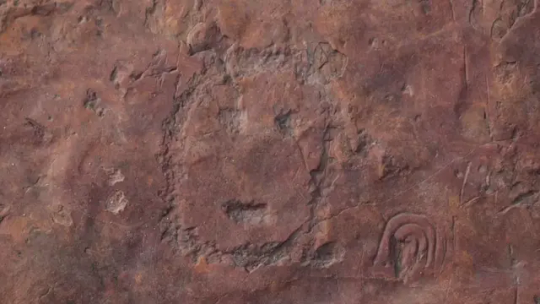
The rocky point is called Ponto das Lajes on the north shore of the Amazon near where the Rio Negro and Solimões rivers join.
Oliveira said the carvings were first seen there in 2010, but this year’s drought has been more severe, with the Rio Negro dropping 15 meters (49.2 feet) since July, exposing vast expanses of rocks and sand where there had been no beaches.
“This time we found not just more carvings but the sculpture of a human face cut into the rock,” said Oliveira, who works for the National Historic and Artistic Heritage Institute (IPHAN) that oversees the preservation of historic sites.
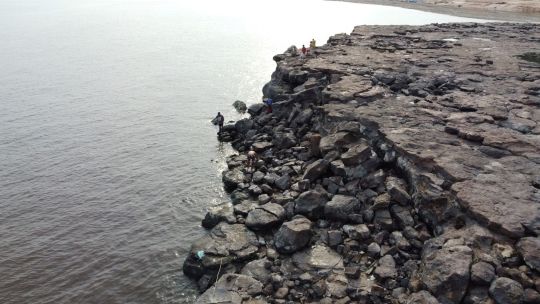
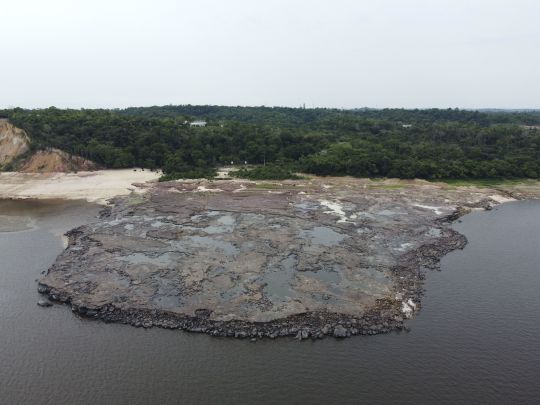
#Amazon Drought Exposes Ancient Rock Carvings#amazon river#Ponto das Lajes#rock carvings#ancient carviings#ancient artifacts#archeology#archeolgst#history#history news#ancient history#ancient culture#ancient civilizations
102 notes
·
View notes
Text

The Amazon is releasing vast amounts of CO2 due to severe drought and heat
#The Amazon is releasing vast amounts of CO2 due to severe drought and heat#amazon#co2 emissions#co2#drought#ausgov#politas#australia#pollution#global warming#science#auspol#tasgov#taspol#fuck neoliberals#neoliberal capitalism#anthony albanese#albanese government
8 notes
·
View notes
Text

Seca em Alter-do-chão (2024). Santarém, Pará, Brasil. Onde está gramado, deveria ser água. Estava tão seco que dava de atravessar andando, até canoas tinham dificuldade de passar pelo canal.
Drought in Alter-do-chão (2024). Santarém, Pará, Brazil. Where there is grass, there should be water. It was so dry that it was possible to cross on foot, even canoes had difficulty passing through the canal.
#fotografia#photography#nature#natureza#praia#beach#seca#drought#amazon#amazônia#alter-do-chão#santarém#pará#brasil#brazil
4 notes
·
View notes
Text
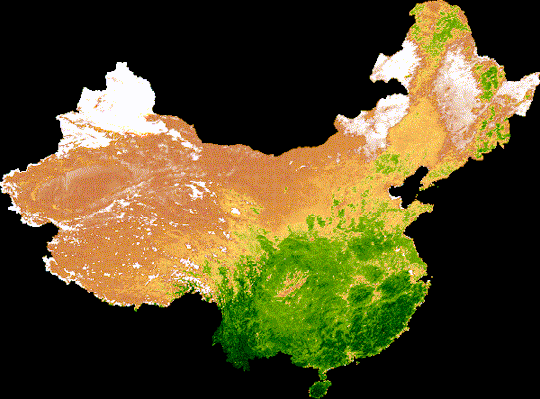
Um de nossos eixos de pesquisa são a elaboração de gifs de series temporais em NDVI ao longo do um ano para analises ambientais, no exemplo acima estuda-se o quanto o deserto de gobi da china avança e recua ao longo de um ano.
#geoprocessamento#geoprocessing#technology#techinnovation#ciencia#science#geology#agriculture#agritech#precisionagriculture#ai#artificial intelligence#machinelearng#website#maps#earth#satellite#drone#drone photography#remote monitoring#python#drought#amazon#amazonia#environment#pollution#ecology#ecosystems#climate#nature
2 notes
·
View notes
Text
7 notes
·
View notes
Text
8 notes
·
View notes
Text
River Dolphins Dying in Hot Water
River dolphins are dying by the dozens in the Brazilian Amazon rainforest over the past week, along with thousands of fish. Experts warn that worse could follow if water temperatures remain elevated due to a severe drought in the region. The Mamiraua Institute, part of Brazil’s Ministry of Science, Technology, and Innovation, reported the discovery of over 100 dead river dolphins over the past…

View On WordPress
#Amazon rainforest#amazon river#Brazil#chico mendes#drought#fish kill#high water temperatures#lake tefe#mamiraua institute#river dolphins
7 notes
·
View notes
Text
youtube
The future of Amazon forest doesn't just impact the forest and nearby countries, it impacts global climate patterns.
5 notes
·
View notes
Text
#science#science communication#scicomm#stem#science education#science blog#environmental science#climate#climate change#climate crisis#climate catastrophe#climate emergency#amazon river#Drought#global warming#environment
4 notes
·
View notes
Text
Cumulative Impact of the Amazon River Basin Drought (Proceedings of the National Academy of Sciences)
Study summarized by Bill McKibben in his Substack blog:
More than a third of the Amazon ‘rainforest’ is struggling to recover from massive drought, new data shows:
The new paper, published in Proceedings of the National Academy of Sciences, examines satellite images of vegetation activity from 2001 to 2019. Tens of thousands of pixels, each covering a 25-sq km (9.65-sq mile) area, were analysed on a month-by-month basis and correlated with local rainfall data.
The authors’ goal was to investigate how “the frequency, intensity, or duration of droughts contributes to stability loss of Amazon vegetation”.
They found 37% of the mature vegetation in the region exhibited a slowing-down trend. While the patterns varied from area to area, they concluded that the highly deforested and degraded south-eastern Amazon was most vulnerable to a “tipping event”: in other words, a calamitous decline of the tropical rainforest to a different, drier state.
4 notes
·
View notes
Text
Severe Drought in the Amazon Reveals Millennia-Old Carvings
— The Millennia-Old Carvings Were Peviously Hidden Under Water.
— By Fernando Crispim and Edmar Barros | Associated Press | October 28, 2023
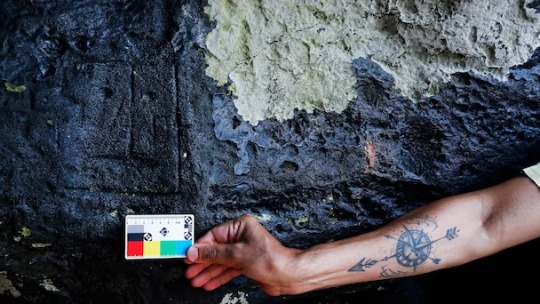
An archaeologist measures rock paintings at the Ponta das Lajes archaeological site, in the rural area of Manaus, Brazil, Saturday, Oct. 28, 2023. The archaeological site was exposed following a drought in the Negro River, unveiling rock paintings that, according to archaeologists, date back between 1,000 and 2,000 years. (AP Photo/Edmar Barros) The Associated Press
MANAUS — The Negro River, the major tributary that runs through the Brazilian Amazon, has reached historic lows, revealing millennia-old carvings previously hidden under water.
The engravings deeply etched into the black rock along the riverbanks represent human faces, animals and other figures, and are thought to be 1,000 to 2,000 years old, archaeologists said.
“They allow us to understand the way of life of prehistoric populations,” Jaime de Santana Oliveira, an archaeologist with Brazil’s National Historic and Artistic Heritage Institute, said.
The scientists think other rocks at the site were used to sharpen arrows and stone tools.
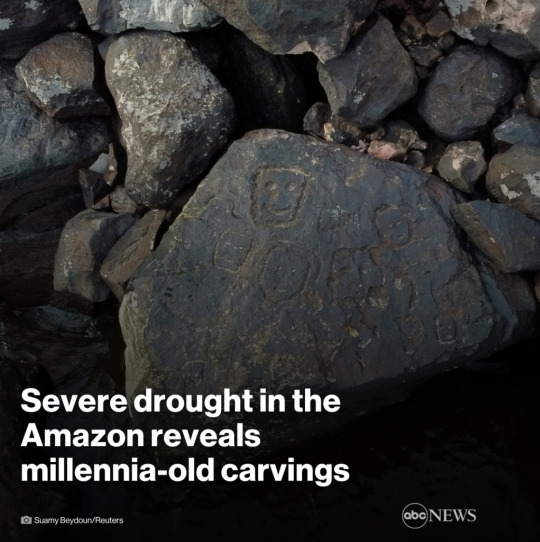

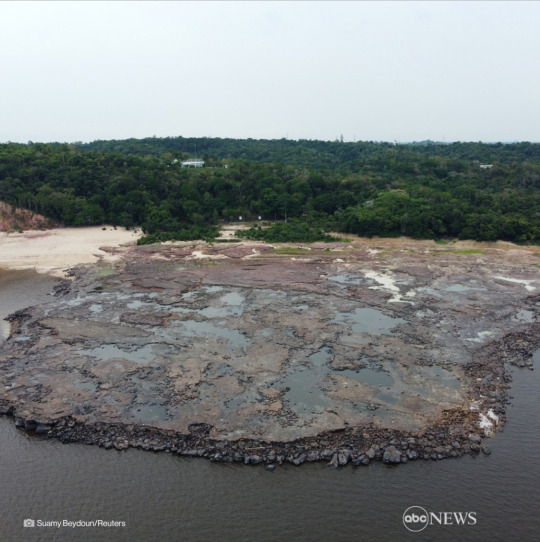

The Ponto das Lajes archaeological site is located in the rural area of Manaus, the largest city and capital of Amazonas state. From there, locals and tourists can observe the “Meeting of Waters,” which occurs when the dark, Coca-Cola-colored Negro River and the pale, clay-colored Solimoes River converge without merging and run parallel to each other over several miles.
The petroglyphs first were spotted in 2010, when another bad drought struck the region, but had not been observable since then before the current drought.
Low river levels in Amazonas have turned once navigable rivers into endless sand banks and mud, leaving hundreds of communities isolated. Public authorities have scrambled to get food and water to those communities in recent weeks.
Earlier this week, The Associated Press observed the delivery of basic goods. Boats had to dock miles away, forcing residents, most of them small farmers and fishermen, to walk long distances.
Manaus and other nearby cities are experiencing high temperatures and heavy smoke from fires set for deforestation and pasture clearance. The drought is also the likely cause of dozens of river dolphin deaths in Tefe Lake, near the Amazon River.
Dry spells are part of the Amazon’s cyclical weather pattern, usually from May to October. This season’s drought has been fiercer than usual due to two climate phenomena: the warming of northern tropical Atlantic Ocean waters and El Niño — the warming of surface waters in the Equatorial Pacific region.
#Severe | Drought#Amazon | Brazil 🇧🇷#Negro River | Carvings#Archaeologist | Jaime de Santana Oliveira#Brazil’s National Historic and Artistic Heritage Institute#Scientists#Dark Coca-Cola-Colored Negro River#The Pale Clay-Colored Solimoes River#The Associated Press#Atlantic Ocean Waters | El Niño
3 notes
·
View notes
Text
while these aren't exactly brazil, they also hearken to similar problems:
hey uh so I haven't seen anyone talking about this here yet, but
the amazon river, like the biggest river in the fucking world, in the middle of the amazon fucking rainforest, is currently going through its worst drought since the records began 121 years ago
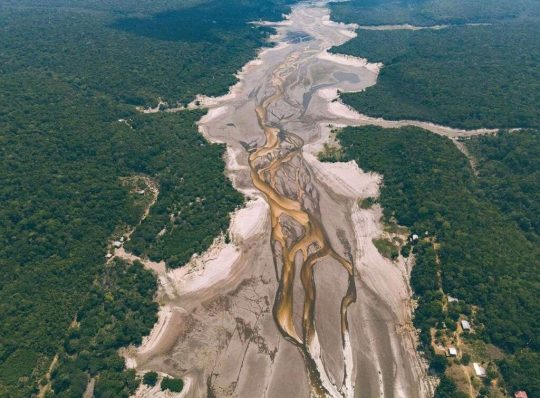
picture from Folha PE
there's a lot going on but I haven't seen much international buzz around this like there was when the forest was on fire (maybe because it's harder to shift the narrative to blame brazil exclusively as if the rest of the world didn't have fault in this) so I wanted to bring this to tumblr's attention
I don't know too many details as I live in the other side of the country and we are suffering from the exact opposite (at least three cyclones this year, honestly have stopped counting - it's unusual for us to get hit by even one - floods, landslides, we have a death toll, people are losing everything to the water), but like, I as a brazilian have literally never seen pictures of the river like this before. every single city in the amazonas state is in a state of emergency as of november 1st.
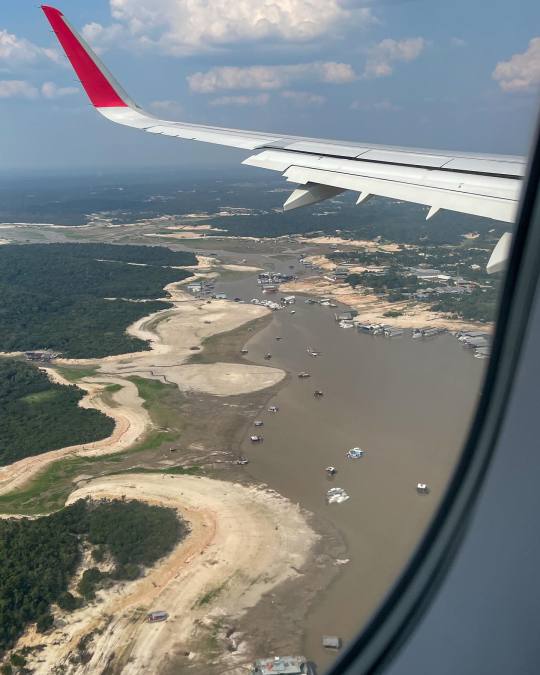

pictures by Adriano Liziero (ig: geopanoramas)
we are used to seeing images of rio negro and solimões, the two main amazon river affluents, in all their grandiose and beauty and seeing these pictures is really fucking chilling. some of our news outlets are saying the solimões has turned to a sand desert... can you imagine this watery sight turning into a desert in the span of a year?
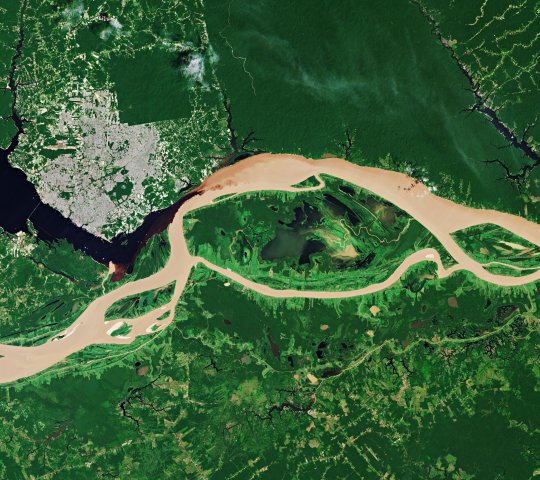
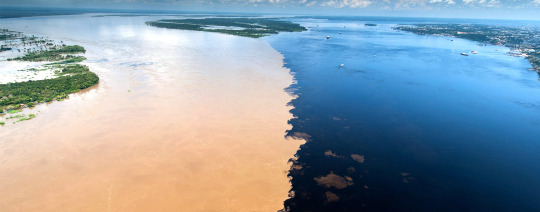
while down south we are seeing amounts of rain and hailstorms the likes of which our infrastructure is simply not built to deal with, up north people who have built everything around the river are at a loss of what to do.
the houses there that are built to float are just on the ground, people who depend on fishing for a living have to walk kilometers to find any fish that are still alive at all, the biodiversity there is at risk, and on an economic level it's hard to grasp how people from the northern states are getting by at all - the main means of transport for ANYTHING in that region is via the river water. this will impact the region for months to come. it doesnt make a lot of sense to build a lot of roads bc it's just better to use the waterway system, everything is built around or floats on the river after all. and like, the water level is so incomprehensibly low the boats are just STUCK. people are having a hard time getting from one place to another - keep in mind the widest parts of the river are over 10 km apart!!
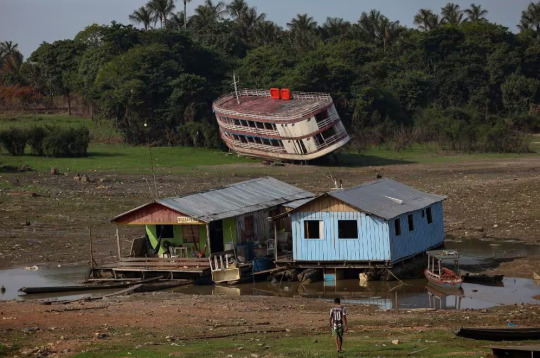
this shit is really serious and i am trying not to think about it because we have a different kind of problem to worry about down south but it's really terrifying when I stop to think about it. you already know the climate crisis is real and the effects are beyond preventable now (we're past global warming, get used to calling it "global boiling"). we'll be switching strategies to damage control from now on and like, this is what it's come to.
I don't like to be alarmist but it's hard not to be alarmed. I'm sorry that I can't end this post with very clear intructions on how people overseas can help, there really isn't much to do except hope the water level rises soon, maybe pray if you believe in something. in that regard we just have to keep pressing for change at a global level; local conditions only would not, COULD NOT be causing this - the amazon river is a CONTINENTAL body of water, it spans across multiple countries. so my advice is spread the word, let your representatives know that you're worried and you want change towards sustainability, degrowth and reduced carbon emissions, support your local NGOs, maybe join a cause, I don't know? I recommend reading on ecological and feminist economics though
however, I know you can help the affected riverine families by donating to organizations dedicated to helping the region. keep in mind a single US dollar, pound or euro is worth over 5x more in our currency so anything you donate at all will certainly help those affected.
FAS - Sustainable Amazon Fundation
Idesam - Sustainable Developent and Preservation Institute of Amazonas
Greenpeace Brasil - I know Greenpeace isn't the best but they're one of the few options I can think of that have a bridge to the international world and they are helping directly
There are a lot of other smaller/local NGOs but I'm not sure how you could donate to them from overseas, I'll leave some of them here anyway:
Projeto Gari
Legião da Boa Vontade
Caritás Brasileira
If you know any other organizations please link them, I'll be sure to reblog though my reach isn't a lot
thank you so much for reading this to the end, don't feel obligated to share but please do if you can! even if you just read up to here it means a lot to me that someone out there knows
also as an afterthought, I wanted to expand on why I think this hasn't made big news yet: because unlike the case of the 2020 forest fires, other countries have to hold themselves accountable when looking at this situation. while in 2020 it was easier to pretend the fires were all our fault and people were talking about taking the amazon away from us like they wouldn't do much worse. global superpowers have no more forests to speak of so I guess they've been eyeing what latin america still has. so like this bit of the post is just to say if you're thinking of saying anything of the sort, maybe think of what your own country has done to contribute to this instead of blaming brazil exclusively and saying the amazon should be protected by force or whatever
7K notes
·
View notes